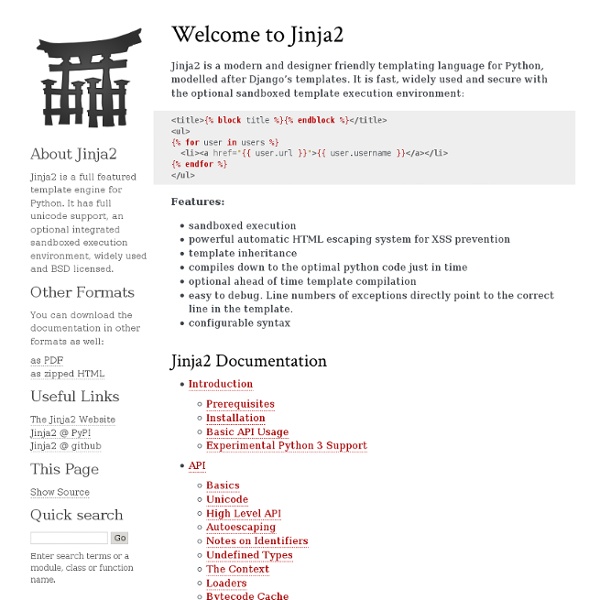Welcome to Jinja2 — Jinja2 2.8-dev documentation
Jinja2 is a modern and designer friendly templating language for Python, modelled after Django’s templates. It is fast, widely used and secure with the optional sandboxed template execution environment: <title>{% block title %}{% endblock %}</title><ul>{% for user in users %} <li><a href="{{ user.url }}">{{ user.username }}</a></li>{% endfor %}</ul> Features: sandboxed executionpowerful automatic HTML escaping system for XSS preventiontemplate inheritancecompiles down to the optimal python code just in timeoptional ahead of time template compilationeasy to debug. Additional Information If you can’t find the information you’re looking for, have a look at the index or try to find it using the search function:
Python Extension Packages for Windows - Christoph Gohlke
by Christoph Gohlke, Laboratory for Fluorescence Dynamics, University of California, Irvine. This page provides 32- and 64-bit Windows binaries of many scientific open-source extension packages for the official CPython distribution of the Python programming language. The files are unofficial (meaning: informal, unrecognized, personal, unsupported, no warranty, no liability, provided "as is") and made available for testing and evaluation purposes. If downloads fail reload this page, enable JavaScript, disable download managers, disable proxies, clear cache, and use Firefox. Most binaries are built from source code found on PyPI or in the projects public revision control systems. Refer to the documentation of the individual packages for license restrictions and dependencies. Use pip version 8 or newer to install the downloaded .whl files. Install numpy+mkl before other packages that depend on it. The files are provided "as is" without warranty or support of any kind. Build Environment
The Django Book
Python Django tutorial 1 installing easy_install, virtualenv & django
7 Python Libraries you should know about
In my years of programming in Python and roaming around GitHub's Explore section, I've come across a few libraries that stood out to me as being particularly enjoyable to use. This blog post is an effort to further spread that knowledge. I specifically excluded awesome libs like requests, SQLAlchemy, Flask, fabric etc. because I think they're already pretty "main-stream". 1. pyquery (with lxml) pip install pyquery For parsing HTML in Python, Beautiful Soup is oft recommended and it does a great job. Just how slow? What immediately stands out is how fast lxml is. So either slow and easy to use or fast and hard to use, right? Wrong! Enter PyQuery Oh PyQuery you beautiful seductress: from pyquery import PyQuerypage = PyQuery(some_html) last_red_anchor = page('#container > a.red:last') Easy as pie. There are some gotchas, like for example that PyQuery, like jQuery, exposes its internals upon iteration, forcing you to re-wrap: 2. dateutil pip install python-dateutil Handling dates is a pain. 5. sh
Kivy NUI Development Framework
The Python Standard Library — Python v2.7.5 documentation
This document is for an old version of Python that is no longer supported. You should upgrade and read the Python documentation for the current stable release. Navigation The Python Standard Library¶ While The Python Language Reference describes the exact syntax and semantics of the Python language, this library reference manual describes the standard library that is distributed with Python. Python’s standard library is very extensive, offering a wide range of facilities as indicated by the long table of contents listed below. The Python installers for the Windows platform usually include the entire standard library and often also include many additional components. In addition to the standard library, there is a growing collection of several thousand components (from individual programs and modules to packages and entire application development frameworks), available from the Python Package Index. Previous topic 9. Next topic 1. This Page Show Source Quick search
Related:
Related:



